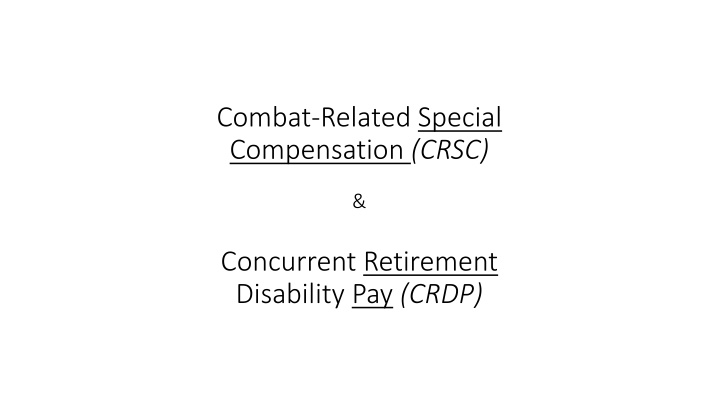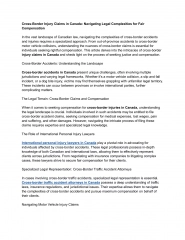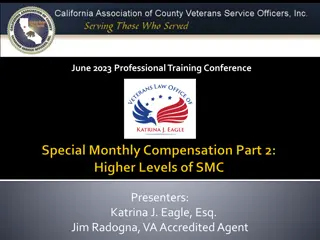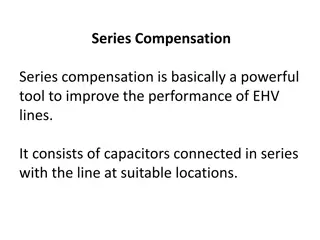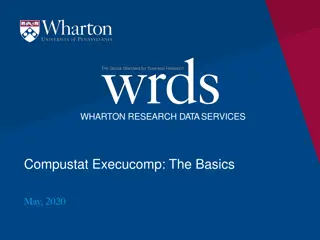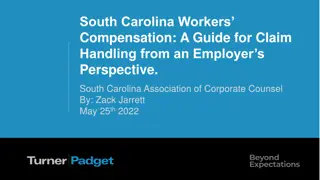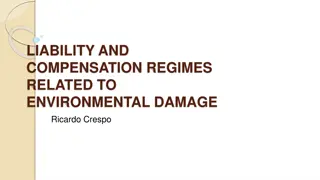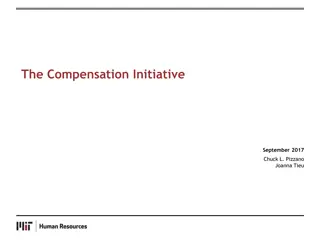Combat-Related Special Compensation (CRSC) Overview
Learn about Combat-Related Special Compensation (CRSC) and Concurrent Retirement Disability Pay (CRDP) which provide benefits to military veterans. Understand eligibility criteria, application process, and differences between CRSC and CRDP. This information will help veterans navigate the complexities of these programs and maximize their entitled benefits effectively.
Uploaded on Feb 16, 2025 | 0 Views
Download Presentation

Please find below an Image/Link to download the presentation.
The content on the website is provided AS IS for your information and personal use only. It may not be sold, licensed, or shared on other websites without obtaining consent from the author.If you encounter any issues during the download, it is possible that the publisher has removed the file from their server.
You are allowed to download the files provided on this website for personal or commercial use, subject to the condition that they are used lawfully. All files are the property of their respective owners.
The content on the website is provided AS IS for your information and personal use only. It may not be sold, licensed, or shared on other websites without obtaining consent from the author.
E N D
Presentation Transcript
Combat-Related Special Compensation (CRSC) & Concurrent Retirement Disability Pay (CRDP)
Nobody said it was going to be fair! This is better than 2002 and before but still not fair.
Agenda What is CRSC? What is CRDP? CRSC vs. CRDP CRSC Claim Workshop 3
CRSC & CRDP Combat Related disabilities and Service Connected disabilities are separate types of disabilities that are obtained under different circumstances Since both CRSC and CRDP seek to restore lost retired pay, they are mutually exclusive can t receive both
What is CRDP? CRDP is Congressionally mandated program providing no VA offset of service connected disability for veterans rated 50-100% and have a longevity based retirement. How does CRDP help retired veterans? Restores the military retired pay that was subtracted from retired pay as VA offset Restores with taxable monthly pay Recognizes veterans for their sacrifice to our country Automatic no additional application required Originally CRDP was phased in from 2004-2014 CRDP is paid by DFAS as retired pay (full amount). 5
CRDP Statutory Authority: 10 U.S.C 1414 DOD Authority: DOD Financial management regulation 7000.14-R Volume 7B, Chapter 64 (CRDP) https://comptroller.defense.gov/portals/45/documents/fmr/current/0 7b/07b_64.pdf
Who is eligible for CRDP? CRDP is generally available to veterans who have: A years of service retirement (includes TERA), and A combined VA disability rating of 50% or higher Veterans who are medically retired and have at least 20 years of service may also be eligible for CRDP.
What is CRSC? CRSC is Congressionally mandated program providing compensation for eligible retired veterans with combat-related injuries who have a 10-100% VA disability rating. CRSC requires the veteran to apply for benefit with their branch of service. How does CRSC help retired veterans? Replaces the VA disability compensation that s subtracted from retired pay Restores military retired pay with tax free monthly payments and is paid retroactively Recognizes veterans for their sacrifice to our country CRSC is a form of compensation paid by DFAS and is a separate (tax free) deposit from retired pay. 8
CRSC Statutory Authority: 10 U.S.C 1413a DOD Authority: DOD Financial management regulation 7000.14-R Volume 7B, Chapter 63 https://comptroller.defense.gov/portals/45/documents/fmr/current/0 7b/07b_63.pdf
CRSC Basic Eligibility Must meet all of the following: CRSC 1. Receiving military retired pay * 2. Military retired pay is reduced by VA disability payments (VA Waiver) 3. 10% or greater VA rated injury that is combat-related * Includes: AC, RC, NG with 20 years of credible service, medical Chapter 61, TERA and TDRL retirees 10
Current 2008 NDAA Changes to CRSC Current 2008 NDAA Changes to CRSC Expanded eligibility: Removed the length of service (20 year) requirement Removed the 10% with Purple Heart or 60% combined CRSC disabilities (2004 Change) Available to any service member receiving military retirement pay for reasons other than for early retirement of reserve members with physical disabilities not incurred in the line of duty under section 12731(b)of title 10 USC
Payments From DFAS and VA Based on CRDP or CRSC DFAS audits VA and DFAS accounts to determine if a retro payment is required. DFAS will forward the audit to VA if it finds that the VA needs to provide a retroactive payment. DFAS on initial application for CRSC and if veteran is also eligible for CRDP. DFAS will automatically award the greater $ amount. Veterans will have a one opportunity to reverse the current decision. After that there is an annual enrolment period (usually January) to change your selection of CRSC or CRDP. Retroactive CRSC payments are limited to 6 years. 12
Service-Related vs. Combat- Related Service-Related Injury directly related to military service Example: Hurt knee during Battalion run at Airborne School Combat-Related Injury Injury contributed to any of the following situations: Examples: Simulating War - hurt knee while reacting to enemy fire during FTX Hazardous Services -hurt knee on a night jump during SF school Instrumentality of War - hit knee on rotating tank turret during FTX Armed Conflict -shot in knee by enemyduring Gulf War 13
Who is Eligible? Must Have at least one combat-related VA Disability Must Have ALL 1. Simulating War (SW) 1. Receiving military retired pay 2. Hazardous Service (HS) 2. Military retired pay is reduced by VA disability payments (VA Waiver) 3. Instrumentality of War (IN) 4. Armed Conflict (AC) 3. Have a 10% or greater VA rated disability Certain presumptive conditions 14
CRSC Claim Workshop
Decision Between CRSC and CRDP Decision Between CRSC and CRDP Benefit Information CRSC CRDP No 10 yr phase in (except 100% ratings) YES Full Concurrent Receipt Yes VA Rating Starts At 10% 50% Federal Tax Tax Free Taxed File Claims Must Apply Automatic Qualified Injury Combat-Linked Service Connected Subject to Uniform Services Former Spouse Protection Act (USFSPA) No Yes SBP (Survivor Benefit Plan) Yes Yes Available to Chapter 61 Medical and TDRL retirees with less than 20 years of service Yes No Available to TERA Retirees Yes Yes 16
Service Service- -Related vs. Combat Related vs. Combat- - Related Related Service Related (CRDP eligibility) An illness or injury which the Soldier incurred while in active military service or which existed prior to entry into active military service and was made worse by such service Combat Related (CRSC eligibility) For the purposes of CRSC, a combat-related illness/injury can be an illness or injury that results from combat or training for combat. It can be caused by any of these situations: Simulations of War (SW) (e.g., FTX, Special Forces training exercises, combat confidence course or lanes training, or other training which is used to prepare for combat) Hazardous Service (HS) (e.g., aerial flight, parachute duty, demolition duty, experimental stress duty, and diving duty) Instrumentalities of War (IN) (e.g., tanks, Agent Orange, grenade simulators, military planes, and other items unique to the military) Armed Conflict (AC) - directly or indirectly (e.g., Purple Heart (PH) injuries or secondary conditions as a result of the injury) Agent orange, Radiation, Gulf War, Mustard Gas 17
Service-Related vs. Combat- Related Service-Related Injury directly related to military service Example: Hurt knee during Battalion run at Airborne School Combat-Related Injury Injury contributed to any of the following situations: Examples: Simulating War - hurt knee while reacting to enemy fire during FTX Hazardous Services -hurt knee on a night jump during SF school Instrumentality of War - hit knee on rotating tank turret during FTX Armed Conflict -shot in knee by enemyduring Gulf War Agent Orange and Gulf war presumptive count as Combat Related. Pact Act Burn Pits according to NVLSP do also. 18
Armed Conflict Direct Result of Armed Conflict 6.1.1. The disability is a disease or injury incurred in the line of duty as a direct result of armed conflict. To support a combat- related determination, it is not sufficient to only state the fact that a member incurred the disability during a period of war, in an area of armed conflict, or while participating in combat operations. There must be a definite causal relationship between the armed conflict and the resulting disability. Armed conflict includes a war, expedition, occupation of an area or territory, battle, skirmish, raid, invasion, rebellion, insurrection, guerilla action, riot, or any other action in which Service members are engaged with a hostile or belligerent nation, faction, force, or with terrorists. Armed conflict may also include incidents involving a member while interned as a prisoner of war, while detained against his or her will in the custody of a hostile or belligerent force, or while escaping or attempting to escape from such confinement, prisoner of war, or detained status. 19
Hazardous Services While Engaged in Hazardous Service Hazardous service is service that includes, but is not limited to, aerial flight, parachute duty, demolition duty, experimental stress duty, and diving duty. A finding that a disability is the result of hazardous service requires that the injury or disease be the direct result of actions taken in the performance of such service. Travel to and from such service, or actions incidental to a normal duty status not considered hazardous, are not included. 20
Instrumentality of War There must be a direct causal relationship between the instrumentality of war and the disability. It is not required that a member s disability be incurred during an actual period of war. The disability must be incurred incident to a hazard or risk of the service. An instrumentality of war is a vehicle, vessel, or device designed primarily for Military Service and intended for use in such service at the time of the occurrence or injury. It may also include such instrumentality not designed primarily for Military Service if use of or occurrence involving such instrumentality subjects the individual to a hazard peculiar to Military Service. Such use or occurrence differs from the use or occurrence under similar circumstances in civilian pursuits. A determination that a disability is the result of an instrumentality of war may be made if the disability was incurred in any period of service as a result of such diverse causes as wounds caused by a military weapon, accidents involving a military combat vehicle, injury or sickness caused by fumes, gases, or explosion of military ordnance, vehicles, or materiel. For example, if a member is engaging in a sporting activity while on a field exercise and falls and strikes an armored vehicle, the injury would not be considered the result of an instrumentality of war (armored vehicle) because it was the sporting activity that was the cause of the injury, not the vehicle. On the other hand, if the individual was engaged in the same sporting activity and the armored vehicle struck the member, then the injury would be considered the result of an instrumentality of war.
In the Performance of Duty Under Conditions Simulating War In general, performance of duty under conditions simulating war covers disabilities resulting from military training, such as war games, practice alerts, tactical exercises, airborne operations, leadership reaction courses, grenade and live fire weapon practice, bayonet training, hand-to-hand combat training, repelling, and negotiation of combat confidence and obstacle courses. It does not include physical training activities such as calisthenics, jogging, formation running, or supervised sport activities. 22
CRSC Claim Pages CRSC Claim Pages: Retired veterans complete pages 1 3 only when submitting a claim (the cover page and the appendix should not be mailed into the CRSC office). There may be multiple page 2s. Each page provides a step-by-step guide to what information is needed 23
Section II Preliminary Requirements Page 1 of DD form 2860 24
Section III - Service History Page 1 of DD form 2860 25
Page 2 Note NOTE: To ensure the review of all of your requested disabilities, Limit ONE disability for each page. You are authorized to make additional copies of this page for any additional disabilities. You may list any secondary conditions that are connected to a disability on the bottom of the sheet that it has been connected to. In order to award any disability as secondary we must have a copy of the evidence from VA or from your medical records which clearly states that the condition is the result of the primary condition you are requesting. Good evidence could include a VA rating decision that clearly states (for example), "hypertension is secondary to diabetes. Include Special monthly compensation (like K1 loss of use due to ED secondary to diabetes) It is your responsibility to supply any evidence necessary to verify this disability is combat- related. 26
Section IV Request for Combat- Related Determination (part 1) Page 2 of DD form 2860 27
Section IV Request for Combat- Related Determination (part 2) Page 2 of DD form 2860 28
Submitting a Successful CRSC Claim Submitting a Successful CRSC Claim DO Submit: A signed claim form Copies of ALL VA rating decisions which include the letter and the narrative summaries Copies of ALL DD214s and DD215s Official documentary evidence that supports HOW the specific disability being claimed meets the criteria for combat-related DO NOT Submit: Medical records that do not pertain to a combat-related disability Electronic media, EKGs, lab slips, or dental records Personal or Buddy statements 31
Documentation Documentation What You Need to Know What You Need to Know CRSC does not have access to your military records Unnecessary paperwork can impede the claim process All documentation must be from a military treatment facility or VA medical center CRSC needs to see a specific event that caused the disability being claimed in the medical documentation you provide CRSC is unable to award any compensation without something official that tells us how you got your injury or what caused your illness 32
Why Claims are Denied Top Reasons CRSC Claims are Not Approved: 1) Official documentation provided does not tell HOW the injury occurred to link it to a combat related event 2) The VA rating decision narrative summary was not provided 3) Claim was not signed by the retiree Before submitting your claim determine... Did I supply evidence that verifies HOW I got the injury? 33
Resources CRSC Form DD form 2860 (also in Vetra Spec) Navy/Marine and Army Reconsideration forms. DOD Financial management regulation 7000.14-R Volume 7B, Chapter 63 (CRSC) https://comptroller.defense.gov/portals/45/documents/fmr/current/07b/0 7b_63.pdf DOD Financial management regulation 7000.14-R Volume 7B, Chapter 64 (CRDP) https://comptroller.defense.gov/portals/45/documents/fmr/current/07b/0 7b_64.pdf DFAS Website - https://www.dfas.mil/RetiredMilitary/disability/Apply-for- CRSC 36
